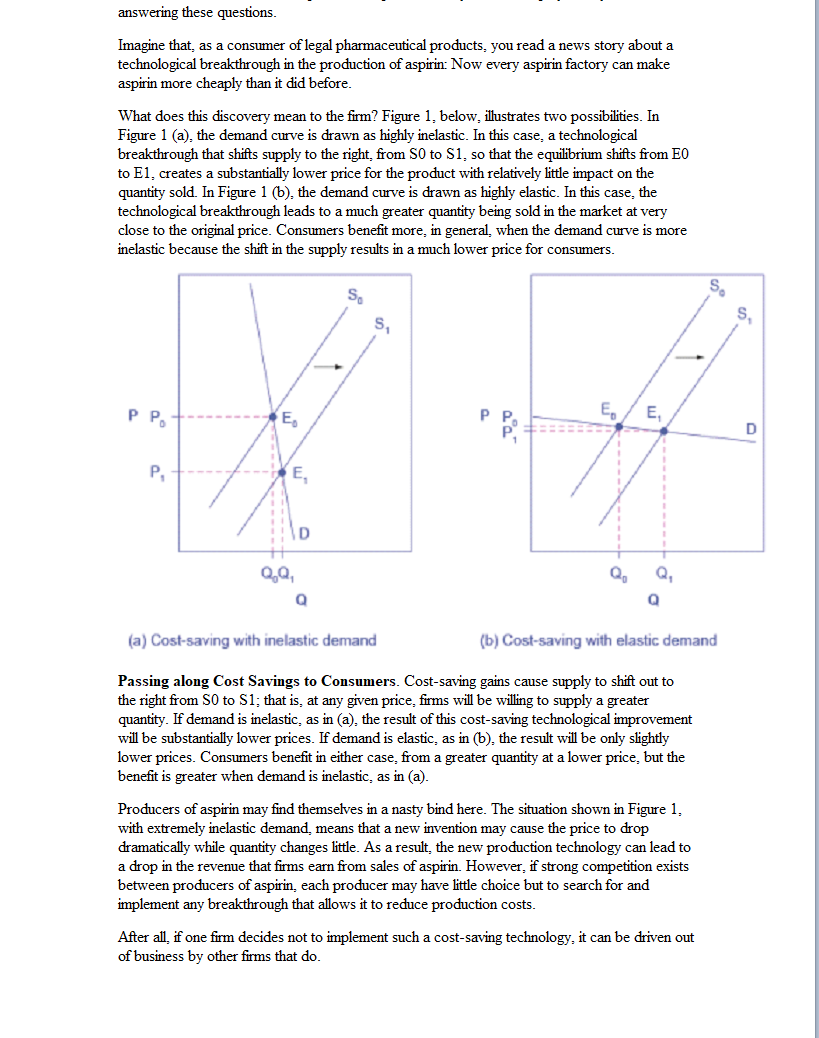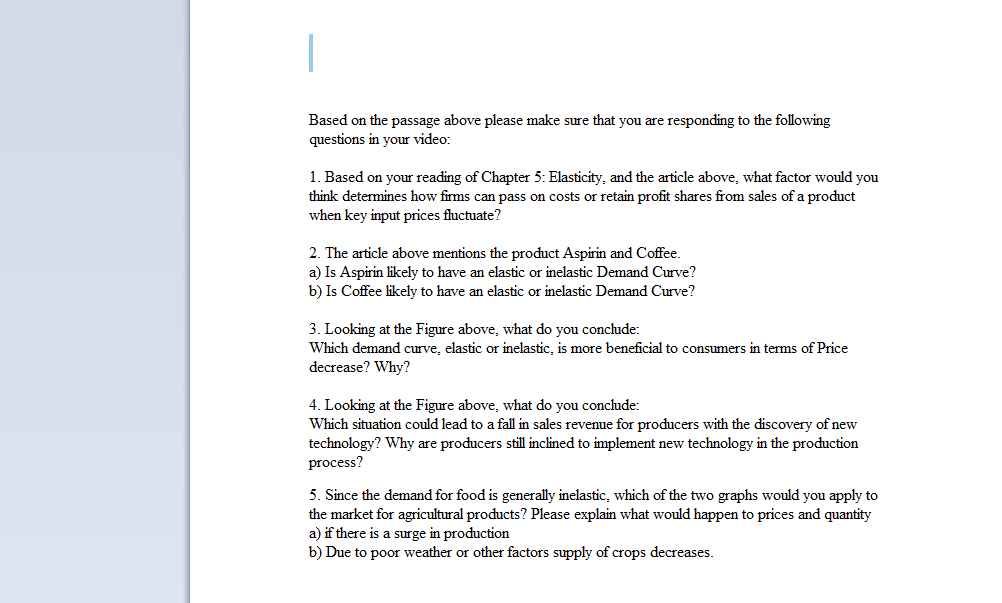plz provide 5 or as many pic for each question that are related to the question below, also it will be nice if u can do it in powerpoint and post screenshot of each question



ECON 1101 - Technical Literacy Assessment MANDATORY ASSIGNMENT Below is a short passage on Elasticity, costs and Customers. At the end of the passage, some questions are given. Assignment:(15 points) 1. You will need to create a short tutorial video not more than 5-8 min long and using your critical thinking and communication skills help your class/audience understand what this passage is talking about. 2. Make sure that within your video you are responding to the 5 questions that have been asked at the end of the passage. 3. Students need to submit a video featuring themselves clearly visible and professionally attired, as if teaching a class. You can use a white board to demonstrate the article and your answers, you can point the camera at your notebook with your graphs as well. You can create a short video using the below, or any other application software of your choice: Once your video is made, please share the link with your instructor. Reading: Elasticity, Costs, and Customers Customers and Changing Costs We can see that understanding elasticity helps a firm set a price that maximizes total revenue. What happens if the firm's production costs change, though? And what is the impact on customers? Most businesses are continually trying to figure out ways to produce at a lower cost, as one path to earning higher profits. It is a challenge to do this, though, when the price of a key input over which a firm has no control rises. If the cost of a key input rises, can the firm pass along those higher costs to consumers in the form of higher prices? For example, many chemical companies use petroleum as a key input, but they have no control over the world market price for crude oil. Coffee shops use coffee as a key input, but they have no control over the world market price of coffee. Conversely, if new and less expensive ways of producing are invented, can the firm keep the benefits in the form of higher profits, or will the market pressure them to pass along the gains to consumers in the form of lower prices? The price elasticity of demand plays a key role in answering these questions. Imagine that, as a consumer of legal pharmaceutical products, you read a news story about a technological breakthrough in the production of aspirin: Now every aspirin factory can make aspirin more cheaply than it did before. What does this discovery mean to the firm? Figure 1, below, illustrates two possibilities. In Figure 1 (a), the demand curve is drawn as highly inelastic. In this case, a technological breakthrough that shifts supply to the right, from S0 to S1, so that the equilibrium shifts from E0 to E1, creates a substantially lower price for the product with relatively little impact on the quantity sold. In Figure 1 (b), the demand curve is drawn as highly elastic. In this case, the technological breakthrough leads to a much greater quantity being sold in the market at very close to the original price. Consumers benefit more, in general, when the demand curve is more inelastic because the shift in the supply results in a much lower price for consumers. (a) Cost-saving with inelastic demand (b) Cost-saving with elastic demand Passing along Cost Savings to Consumers. Cost-saving gains cause supply to shift out to the right from S0 to S1; that is, at any given price, firms will be willing to supply a greater quantity. If demand is inelastic, as in (a), the result of this cost-saving technological improvement will be substantially lower prices. If demand is elastic, as in (b), the result will be only slightly lower prices. Consumers benefit in either case, from a greater quantity at a lower price, but the benefit is greater when demand is inelastic, as in (a). Producers of aspirin may find themselves in a nasty bind here. The situation shown in Figure 1, with extremely inelastic demand, means that a new invention may cause the price to drop dramatically while quantity changes little. As a result, the new production technology can lead to a drop in the revenue that firms earn from sales of aspirin. However, if strong competition exists between producers of aspirin, each producer may have little choice but to search for and implement any breakthrough that allows it to reduce production costs. After all, if one firm decides not to implement such a cost-saving technology, it can be driven out of business by other firms that do. Based on the passage above please make sure that you are responding to the following questions in your video: 1. Based on your reading of Chapter 5 : Elasticity, and the article above, what factor would you think determines how firms can pass on costs or retain profit shares from sales of a product when key input prices fluctuate? 2. The article above mentions the product Aspirin and Coffee. a) Is Aspirin likely to have an elastic or inelastic Demand Curve? b) Is Coffee likely to have an elastic or inelastic Demand Curve? 3. Looking at the Figure above, what do you conclude: Which demand curve, elastic or inelastic, is more beneficial to consumers in terms of Price decrease? Why? 4. Looking at the Figure above, what do you conclude: Which situation could lead to a fall in sales revenue for producers with the discovery of new technology? Why are producers still inclined to implement new technology in the production process? 5. Since the demand for food is generally inelastic, which of the two graphs would you apply to the market for agricultural products? Please explain what would happen to prices and quantity a) if there is a surge in production b) Due to poor weather or other factors supply of crops decreases. ECON 1101 - Technical Literacy Assessment MANDATORY ASSIGNMENT Below is a short passage on Elasticity, costs and Customers. At the end of the passage, some questions are given. Assignment:(15 points) 1. You will need to create a short tutorial video not more than 5-8 min long and using your critical thinking and communication skills help your class/audience understand what this passage is talking about. 2. Make sure that within your video you are responding to the 5 questions that have been asked at the end of the passage. 3. Students need to submit a video featuring themselves clearly visible and professionally attired, as if teaching a class. You can use a white board to demonstrate the article and your answers, you can point the camera at your notebook with your graphs as well. You can create a short video using the below, or any other application software of your choice: Once your video is made, please share the link with your instructor. Reading: Elasticity, Costs, and Customers Customers and Changing Costs We can see that understanding elasticity helps a firm set a price that maximizes total revenue. What happens if the firm's production costs change, though? And what is the impact on customers? Most businesses are continually trying to figure out ways to produce at a lower cost, as one path to earning higher profits. It is a challenge to do this, though, when the price of a key input over which a firm has no control rises. If the cost of a key input rises, can the firm pass along those higher costs to consumers in the form of higher prices? For example, many chemical companies use petroleum as a key input, but they have no control over the world market price for crude oil. Coffee shops use coffee as a key input, but they have no control over the world market price of coffee. Conversely, if new and less expensive ways of producing are invented, can the firm keep the benefits in the form of higher profits, or will the market pressure them to pass along the gains to consumers in the form of lower prices? The price elasticity of demand plays a key role in answering these questions. Imagine that, as a consumer of legal pharmaceutical products, you read a news story about a technological breakthrough in the production of aspirin: Now every aspirin factory can make aspirin more cheaply than it did before. What does this discovery mean to the firm? Figure 1, below, illustrates two possibilities. In Figure 1 (a), the demand curve is drawn as highly inelastic. In this case, a technological breakthrough that shifts supply to the right, from S0 to S1, so that the equilibrium shifts from E0 to E1, creates a substantially lower price for the product with relatively little impact on the quantity sold. In Figure 1 (b), the demand curve is drawn as highly elastic. In this case, the technological breakthrough leads to a much greater quantity being sold in the market at very close to the original price. Consumers benefit more, in general, when the demand curve is more inelastic because the shift in the supply results in a much lower price for consumers. (a) Cost-saving with inelastic demand (b) Cost-saving with elastic demand Passing along Cost Savings to Consumers. Cost-saving gains cause supply to shift out to the right from S0 to S1; that is, at any given price, firms will be willing to supply a greater quantity. If demand is inelastic, as in (a), the result of this cost-saving technological improvement will be substantially lower prices. If demand is elastic, as in (b), the result will be only slightly lower prices. Consumers benefit in either case, from a greater quantity at a lower price, but the benefit is greater when demand is inelastic, as in (a). Producers of aspirin may find themselves in a nasty bind here. The situation shown in Figure 1, with extremely inelastic demand, means that a new invention may cause the price to drop dramatically while quantity changes little. As a result, the new production technology can lead to a drop in the revenue that firms earn from sales of aspirin. However, if strong competition exists between producers of aspirin, each producer may have little choice but to search for and implement any breakthrough that allows it to reduce production costs. After all, if one firm decides not to implement such a cost-saving technology, it can be driven out of business by other firms that do. Based on the passage above please make sure that you are responding to the following questions in your video: 1. Based on your reading of Chapter 5 : Elasticity, and the article above, what factor would you think determines how firms can pass on costs or retain profit shares from sales of a product when key input prices fluctuate? 2. The article above mentions the product Aspirin and Coffee. a) Is Aspirin likely to have an elastic or inelastic Demand Curve? b) Is Coffee likely to have an elastic or inelastic Demand Curve? 3. Looking at the Figure above, what do you conclude: Which demand curve, elastic or inelastic, is more beneficial to consumers in terms of Price decrease? Why? 4. Looking at the Figure above, what do you conclude: Which situation could lead to a fall in sales revenue for producers with the discovery of new technology? Why are producers still inclined to implement new technology in the production process? 5. Since the demand for food is generally inelastic, which of the two graphs would you apply to the market for agricultural products? Please explain what would happen to prices and quantity a) if there is a surge in production b) Due to poor weather or other factors supply of crops decreases









